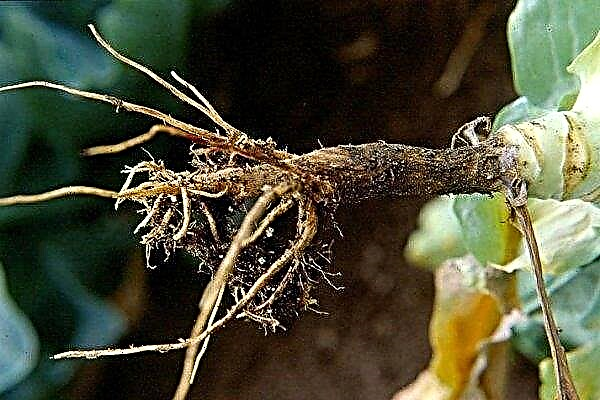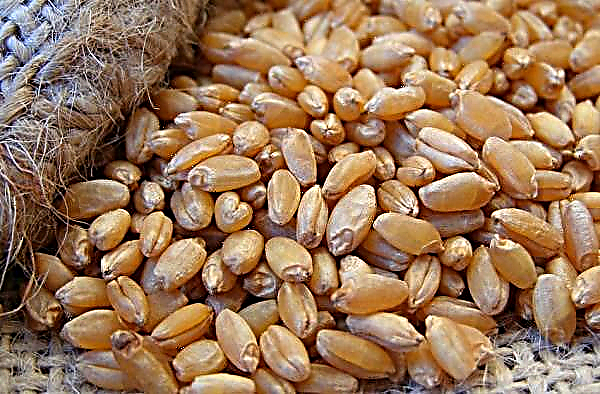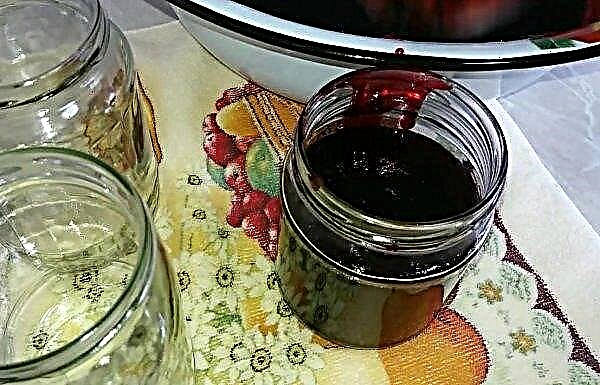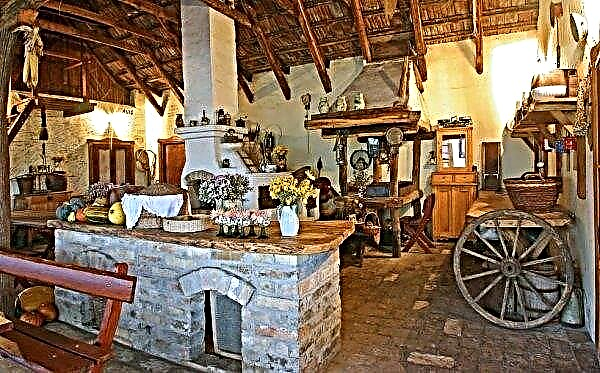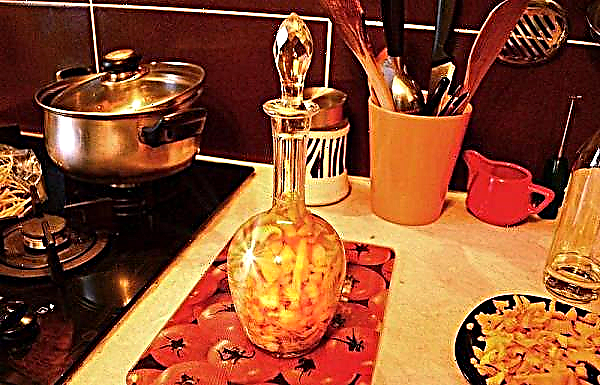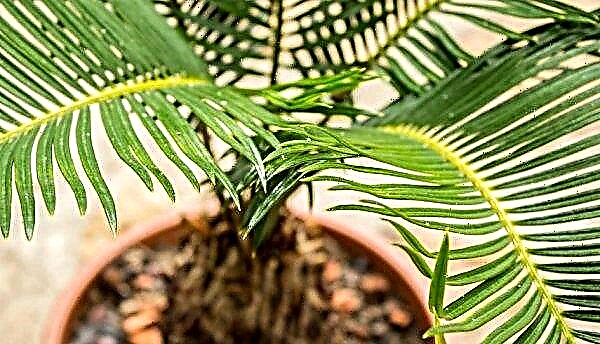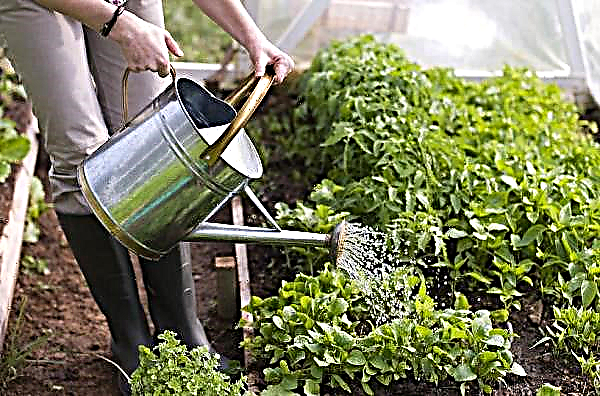Lovers of large plants appreciate the palm of chrysalidocarpus for its exotic and solemn appearance. We offer to get to know her closer and learn how to plant and grow it.
Botanical description of the plant
Other names - areca, palm butterfly, golden butterfly. It grows with a bush and has a lush crown that can decorate any room. In an apartment, it reaches a height of 2 m, when kept in open ground - up to 10 m.
Plant characteristics:
| Root system | Well developed, vertical |
| The stalks | Thin, contain 40-60 leaves |
| Leaf shape | Cirrus, finely dissected |
| Leaf color | Dark and bright green with yellow stalks, smooth edges and pointed ends |
| Flower shape | Inflorescences in the form of panicles |
| Flower color | Bright yellow, cream |
The plant blooms in May and June. However, in an apartment environment it does this rarely. After flowering, yellow, dark purple fruits with seeds appear.
Important! The seeds of chrysalidocarpus are poisonous and, when ingested, lead to poisoning. If there are children in the house, then when the fruits appear, it is necessary to ensure that they do not eat them.
- The benefits of chrysalidocarpus are:
- exotic look;
- unpretentiousness;
- tolerance for drafts;
- ease in reproduction.
Main types
There are two dozen varieties of areca. At home, two are grown:
- Chrysalidocarpus yellowish, or diptis yellowing. It has 2–4 trunks on which cirrus leaves with yellow furrow cuttings 60 cm long are placed. It rarely brings fruits at home.

- Chrysalidocarpus Madagascar. It has one smooth trunk with a diameter of 20-30 cm, on which rings are clearly distinguishable. The leaves are pinnate, glossy, grow in a bunch. In width they reach 2 cm, in length - 40. An inflorescence is formed 50 cm long.

House growing conditions
Chrysalidocarpus is an unpretentious plant, a beginner in the flower business will also cope with the care. After buying a palm tree, flower growers are not advised to immediately transplant. It is better to wait a bit, give time to the plant to adapt to new growing conditions.
Lighting
Since the plant is large, then before purchasing, think about where to put it. This tropical flower is used to sunlight, so you need to choose a well-lit place for it - near the south or southeast windows. The direct rays of the sun are dangerous for palm trees. Therefore, it is necessary to take care of protection from them when they directly fall on the flower.

A palm tree requires daylight hours of 12 hours, so in winter additional lighting is required.
Important! For uniform growth of the areca crown, it is necessary twice a month to expand the pot 180 °.
Temperature
The temperature for palm growth is +22 ... + 25 degrees. In winter - within +16 ... + 23 degrees.
It is important to adhere to the recommended temperatures when growing young plants. Mature palm trees do not react so sharply to short-term drops or increases on the thermometer column.

During the heating period, the flower needs to be moved away from heating appliances, batteries. For the summer season it can be taken out to the balcony.
Air humidity
Humidity in the room where areca grows is maintained at a level of at least 60%. In summer, you need frequent spraying, wiping the leaves with a wet cloth.

In winter, hydration of the flower by spraying and rubbing is not needed. Indoors, it is advisable to install a humidifier.
Home Care
Decorativeity can be achieved if you create optimal conditions for the flower and adhere to the recommendations for care: watering, top dressing, pruning, transplanting.
Watering
Chrysalidocarpus should be watered with warm, standing (at least two days) or filtered water. Watering is plentiful, but make sure that the pot does not stagnate. Watering is carried out as the top layer of an earthen coma dries up - about once every 3 days. In summer, the frequency and volume of irrigation is increased, in winter - reduced.
Important! When watering, make sure that drops of water do not fall on the stems; if this happens, you need to get the stems wet with a dry cloth.
Top dressing
Areca needs to be fertilized year-round. In the spring-summer season, you will need to feed once every two weeks. In the autumn-winter - once a month.

Fertilizers are used for fertilizing for palm trees and ornamental-deciduous plants. During the growing season, monthly foliar top dressing is desirable.
Pruning
Since chrysalidocarpus does not have shoots, there is no need to trim it. Damaged, shriveled leaves are often inspected and cleaned.
Transfer
Areca transplanted in April. Young palm trees are transplanted every year, mature - once every three years.

For this, soil is acquired, which should have the following characteristics:
- acidic or neutral pH;
- good conductivity of air and moisture.
The substrate can be prepared with your own hands by mixing:Did you know? The poisonous fruits of areca are used by some peoples in folk medicine. Means based on them are used to get rid of worms and as a bonding agent. Filipinos make chewing gum from fruits.
- clay-soddy soil (2 parts);
- humus-leaf soil (2 parts);
- peat (1 part);
- coarse sand (1 part);
- charcoal (1 part).

The pot is selected large, with a wide base. A drainage layer, for example, expanded clay or fragments of red brick, is necessarily laid at its bottom.
During the transplant, the earthen lump is not destroyed, it is transshipped. Allowed only to cut off too long roots.
If the areca has grown too much, and it is impossible to transship it, only the topsoil should be replaced.

Breeding
Areca is propagated in two ways:
- Seed.
- Basal processes.
Seeds
It is rare to resort to the seed method at home, since it is troublesome. Seeds for swelling are placed for three days in warm water. Then deepen into moist, light soil and place in conditions with a temperature of +25 ... + 30 ° C and good lighting. After the first leaf appears, the sprouts dive into separate pots. Sprouts that can be planted in a permanent place will appear after 3-4 months.
Video: Areca palm breeding at home
Basal processes
The method is used at any time of the year. A sharp knife cut off the process at the base of the stem. It is desirable that he already had roots. If there are no roots, it is rooted in a tank with moist soil or water. Rooted processes are planted in moist soil and periodically watered. They are planted in a permanent place in spring or summer.
Did you know? Chrysalidocarpus refers to plants that clean the room where it grows. It is believed that it is able to remove elements such as benzene, formaldehyde, carbon monoxide from the air.
Growing difficulties
Improper conditions of detention and errors in care lead to the fact that the plant is affected by diseases and parasites. Some of them can be combated with alternative methods and special drugs, and some can not be treated.
Disease
Most often, chrysalidocarpus is infected by fungal infections. The main symptom is dark spots with a yellow rim on the leaves, the middle of which subsequently dies. Such diseases occur with high humidity and excessive watering. In order to prevent ailments, it is necessary to adhere to the recommended frequency of irrigation, not to overdo it with spraying. The treatment should be carried out with fungicides permitted for decorative and deciduous plants, for example: “Topaz”, “Khom”, “Skor”, “Tiovit”.
Pests
- Thrips. The fact that they settled on the plant is indicated by small holes in the leaves, brown spots, deformation of the stems. Their reproduction is facilitated by dry air and the absence of spraying. They treat a palm tree by spraying with Actellik, Inta-Vir, Fitoverm, Aktara insecticides.

- Spider mite. Appears when the air in the room is too dry. Symptoms of a lesion are a web on the trunk and leaves. The fight is carried out by increasing humidity and spraying with the Aparolo, Borneo, Flumayt acaricides, Fitoverm, Actellik insecticides and other drugs.
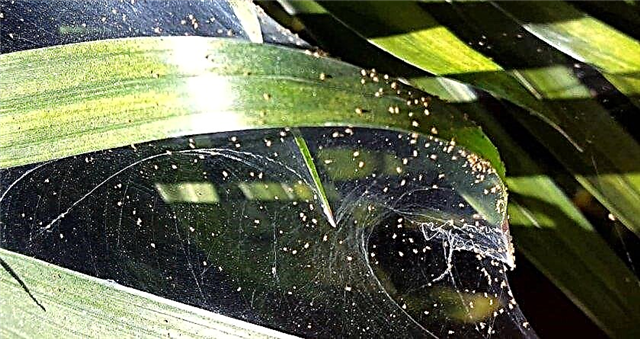
- Nematodes. They can affect leaves, stems and roots. When infected with a nematode, a houseplant must be disposed of with the pot.

- Mealybug. These pests provoke a weakening of the flower and a delay in its growth. In order to prevent damage, a normal level of humidity should be maintained and watering regimes should be observed, and dried leaves should be removed in a timely manner. The struggle consists in wiping with a soap solution, spraying with a solution of green soap, infusions of garlic, tobacco, “Aktara”, “Biotlin”, “Calypso”, “Confidor”, “Fitoverm” preparations.

- Shield. The main symptom is brown spots on the leaves. For treatment, rubbing with a soap-alcohol solution (15 g of liquid soap + 10 ml of denatured alcohol + 1 l of water), spraying with Actellik, Fosbetsid, and Aktara are used.

In addition to diseases, when growing a palm tree, there are other difficulties:Important! When using insecticides and fungicides, it is necessary to strictly adhere to the instructions attached to the drug and observe personal safety measures - protect eyes, hands, nose and mouth, do not eat, drink or smoke during the procedure.
- The leaves turn yellow and curl. This indicates that the flower is hot or too much light. It is necessary to change the nature of the lighting to diffused or to rearrange the flowerpot in another place.
- Darkening and drying out of leaves - A sign of dry air, moisture deficiency, exposure to cold. It is necessary to determine the exact cause and eliminate it.
- Brown spots on the leaves found when the flower is poured, watered with hard water, when it experiences sharp temperature changes. To correct the situation, watering is normalized and the temperature is controlled.
- Leaves blacken or darken with an excess of moisture and decay of the rhizome. Transplantation and normalization of the irrigation regime will help.










